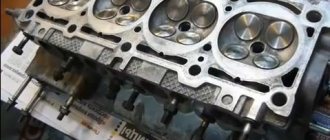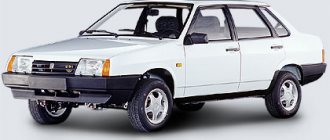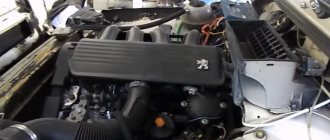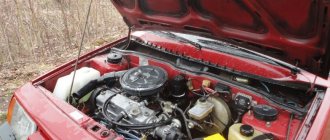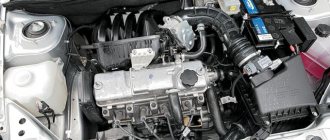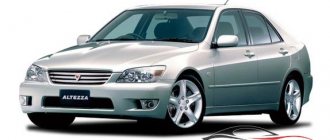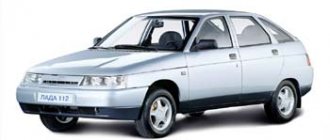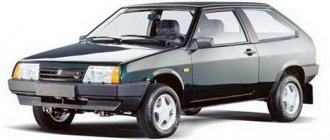Download .xls file
xls
Download picture
Send by email
| PARAMETER | MEANING |
| Number of cylinders | 4 |
| Volume, l | 1.596 |
| Piston stroke, mm | 75.6 |
| Compression ratio | 11 |
| Number of valves per cylinder | 4 |
| Cylinder block material | Ductile iron |
| Supply system | injector |
| Gas distribution system | DOHC |
| Cylinder operating order | 1-3-4-2 |
| Rated motor power | 78 kW (106.0 hp)/ 5800 rpm |
| Maximum torque | 148 Nm / 4000 rpm |
| Supply system | Electronically controlled distributed injection |
| Min octane number of gasoline used | 95 |
| Recommended Engine Oil | Synthetic |
| 5W-30 | |
| 5W-40 | |
| 10W-30 | |
| 10W-40 | |
| 15W-40 | |
| Oil volume in the lubrication system | 3.5 l |
| Oil quantity when changing | 3-3.2 l |
| Engine weight included, kg | 116 |
| Oil change carried out, km | 10000 |
The motor is installed on LADA Priora, Lada Kalina 2 and Lada Granta.
Description
The new VAZ 21127 engine is based on the VAZ-21126 gasoline engine, the main engine of the Priora, and is practically no different from it.
At the same time, the new Priora engine has some features:
- The engine is equipped with an intake control system, due to which it was possible to increase its power from 98 to 106 horsepower. With a 106 hp engine, according to owners' reviews, overtaking has become calmer.
- At the same time, the torque increased slightly to 148 Nm. The increase at average speed of the 127 engine was 10 Nm, which affected the dynamic characteristics of the engine.
- The engine control controller has received new calibrations, and instead of a mass air flow sensor, a DBP (absolute pressure sensor) is used. As a result of the modification, the VAZ 21127 engine received more improved parts.
Boring the Priora engine or how to increase the volume
Let's start with how you don't need to increase the volume, an example would be the famous VAZ 21128 engine, don't do that)). One of the easiest options to increase volume is to install a motorcycle kit, for example STI, we choose it for our 197.1 mm block, but do not forget about the jambs of the 128 engine, do not rush to install a long-stroke elbow. You can go the other way and purchase a high block 199.5 mm Priora, 80 mm crankshaft, bore the cylinders to 84 mm and a connecting rod 135.1 mm pin 19 mm, this will give a total of 1.8 volume and without damage to R/S, the engine can be twist freely, install evil shafts and squeeze out more power than a regular 1.6l. To spin your engine even more, you can build up a standard block with a plate, how to do it, how it spins on a 4-throttle intake and wide shafts.
Design
- The four-stroke 127 engine of the Lada Priora has an in-line cylinder arrangement and a distributed injection system; The camshaft is located at the top of the engine.
- Closed cooling system with forced coolant circulation.
- A combined type lubrication system is supplied to the rubbing surfaces using pressure and oil spraying.
- The high-strength cast iron cylinder block is made by casting, and the walls are processed in accordance with Federal Mogul technology. Cylinder counting begins from the crankshaft drive pulley side.
About Lada Priora engines 1st generation (2007 - present)
The 21116 engine is, in fact, a modified 21114 1.6 liter power unit. The VAZ21116 engine differs from the VAZ 21114 power unit, which is a lighter ShPG produced by Federal Mogul. The engine has a cylinder block similar to the cylinder block of the VAZ 21126. Among the positive aspects of the engine, one can note a reduction in noise and fuel consumption. The engine is also characterized by increased environmental friendliness and power.
The engine has a timing belt drive. Engine VAZ 21116 1.6 l. is an in-line injection engine, it has four cylinders and an overhead camshaft.
ENGINE DISADVANTAGES
In terms of engine malfunctions and weaknesses, the following are noted. The engine is noisy and knocking. In addition, the engine can triple. If the timing belt breaks, the engine may bend the valves. In addition, in practice, the engine life is lower than what is officially declared.
ENGINE VAZ21126
The 21126 engine is a continuation of the VAZ 21124 power unit, which has a 39% lighter ShPG from Federal Mogul. This is an engine with reduced valve holes and a timing belt with an automatic tensioner. Due to this, the problem of timely belt tension disappeared. In terms of the block, we have higher quality surface treatment and high requirements for honing cylinders to Federal Mogul standards.
VAZ 21126 1.6 l. It is an in-line injection engine, it has four cylinders and overhead camshafts. In general, the engine is considered quite good, especially for the city.
ENGINE DISADVANTAGES
Owners note uneven operation and loss of engine power. In addition, the timing belt is not particularly reliable. Uneven operation of the engine can be caused by problems with fuel pressure, timing problems, faulty sensors, air leaks through hoses, or a malfunction of the throttle valve. In case of loss of power, the reason must be sought in low cylinder compression, wear of cylinders, piston rings, and burnout of pistons. If the timing belt breaks, the engine may bend the valves. The problem is solved by replacing the standard pistons with weldless ones.
ENGINE VAZ 21127
Engine VAZ 21127 1.6 l. 106 hp can be called a relatively new VAZ engine. It is a continuation of the Priora engine 21126 and is based on the same block 21083 with some modifications. This is an in-line engine, injection type, the engine has four cylinders, and overhead camshafts. The timing drive uses a belt. A specific feature of the VAZ 21127 engine is the presence of an intake system with a resonance chamber, the volume of which can be adjusted using dampers designed for this purpose.
ENGINE DISADVANTAGES Engine 21127 bends the valves when the timing belt breaks. In addition, the engine is noisy, knocking, and knocking. Owners note uneven operation and loss of engine power. In addition, the timing belt is not particularly reliable. Uneven operation of the engine can be caused by problems with fuel pressure, timing problems, faulty sensors, air leaks through hoses, or a malfunction of the throttle valve. In case of loss of power, the reason must be sought in low cylinder compression, wear of cylinders, piston rings, and burnout of pistons.
ENGINE VAZ 21128
Initially, the 128 engine was created on the basis of the VAZ 21124 power unit. Unlike the last, the VAZ 21128 received cylinders bored out by 0.5 mm, a crankshaft with a stroke of 84 mm, a connecting rod of 129 mm, and lightweight pistons. The timing drive uses a belt, and if it breaks, the engine tears the valves. The cylinder head is similar to the 124 engine, the combustion chambers are slightly modified.
Engine VAZ 21128 1.8 l. It is in-line, injection type, has four cylinders and overhead camshafts.
ENGINE DISADVANTAGES
The main complaint about the engine can be called the low practical resource noted by users. In addition, the engine is subject to significant wear. The engine is quite thirsty for oil. The VAZ 21128 engine quite quickly reaches a state in which it requires major repairs. In addition, the engine is characterized by shaking, knocking and noise during operation. The engine is also susceptible to overheating. And in general, owner reviews about this engine are negative.
| Engine | VAZ 21116/11186 | VAZ 21126 | VAZ 21127 | VAZ 21128 |
| Years of manufacture | 2011 - present day | 2007 - present day | 2013 - present day | 2003 - present day |
| Cylinder block material | cast iron | cast iron | cast iron | cast iron |
| Supply system | injector | injector | injector | injector |
| Type | in-line | in-line | in-line | in-line |
| Number of cylinders | 4 | 4 | 4 | 4 |
| Valves per cylinder | 2 | 4 | 4 | 4 |
| Piston stroke | 75.6 mm | 75.6 mm | 75.6 mm | 84 mm |
| Cylinder diameter | 82 mm | 82 mm | 82 mm | 82.5 mm (82 mm since 2014) |
| Compression ratio | 10,5 | 11 | 11 | 10,5 |
| Engine capacity | 1596 cm cube | 1597 cm cube | 1596 cm cube | 1796 cm cube (1774 cm cube since 2014) |
| Power | 87 hp /5100 rpm | 98 hp /5600 rpm | 106 hp /5800 rpm | 98 hp /5200 rpm (123 hp/5500 rpm) |
| Torque | 140Nm/3800 rpm | 145Nm/4000 rpm | 148Nm/4000 rpm | 162Nm/3200 rpm (165 Nm/4000 rpm) |
| Fuel | AI95 | AI95 | AI95 | AI95 |
| Fuel consumption | ||||
| city | 8.5 l/100 km | 9.8 l/100 km | — | 9.8 l/100 km |
| track | 5.7 l/100 km | 5.4 l/100 km | — | 5.4 l/100 km |
| mixed | 7.2 l/100 km | 7.2 l/100 km | 7 l/100 km | 7.5 l/100 km |
| Oil consumption | 50 g/1000 km | 50 g/1000 km | 50 g/1000 km | about 300 g/1000 km |
| Oil type | 5W-30 5W-40 10W-40 15W40 | 5W-30 5W-40 10W-40 15W40 | 5W-30 5W-40 10W-40 15W40 | 5W-30 5W-40 10W-40 15W40 |
| How much oil is in the engine | 3.5 l | 3.5 l | 3.5 l | 3.5 l |
| When replacing, pour | 3.2 l | 3.2 l | 3.2 l | 3.2 l |
| Resource | ||||
| according to the plant | 200 thousand km | 200 thousand km | 200 thousand km | 200 thousand km |
| on practice | — | 200 thousand km | 200 thousand km | — |
| Tuning | ||||
| potential | 180+ hp | 400+ hp | 400+ hp | 400+ hp |
| without loss of resource | up to 120 hp | up to 120 hp | up to 120 hp | up to 120 hp |
| The engine was installed | Lada Granta Lada Kalina 2 Lada Priora | Lada Priora Lada Kalina Lada Granta Lada Kalina 2 VAZ 2114 Super Auto (211440-26) | Lada Priora Lada Kalina 2 Lada Granta | Lada Priora 1.8 VAZ 21124-28 Lada 112 Coupe 1.8 VAZ 21104-28 |
Service
The power unit must undergo periodic maintenance every 10 thousand kilometers. Under severe operating conditions, oil and filter changes should be carried out every 7.5 thousand.
When replacing the oil filter, you should pay attention to oil leakage through the valve cover seals. This malfunction is due to the poor quality of the sealing gasket, which leads to contamination of the cooling surfaces and overheating of the motor.
A special feature of the maintenance of this engine is the periodic replacement of hydraulic valve compensators.
When operating a car with this engine, its temperature should be controlled - 95-98 degrees Celsius, otherwise the elements of the cooling system will wear out very quickly. The cause of this is usually the thermostat, which is the weak element in this system.
Removal of the exhaust pipe should be carried out with extreme caution; instead of copper nuts, the manufacturer installed steel ones; if they sour, the mounting brackets can break off. When carrying out this type of work, it is better to immediately replace these nuts with copper ones.
The worst feature of this engine is that when it fails, the engine bends the timing valve, leading to expensive repairs. Tensioning and replacing the timing belt is best done at a service center. The Lada Priora engine has 106 hp. p., according to reviews from owners, high-quality oil should be poured, otherwise the hydraulic valve compensators will fail very quickly.
The engine is also marked by knocking in the elements of the crank mechanism, main and connecting rod bearings, while the engine shakes.
Signs of the need for internal combustion engine repair
The reasons why the operation of the engine is disrupted are arranged in a small list, starting with refusal to start and ending with floating idle speed (this problem was removed on the 127 “engine”). Not all breakdowns end in capital damage - sometimes it’s enough to add oil, sometimes it’s enough to adjust the ECU settings.
Compression reduction
A decrease in cylinder compression below 16 atmospheres is a bad sign. Such a high limit corresponds to a compression ratio of 11.
If the compression decreases (or vice versa increases), then the “engine” will have to be rebuilt.
Knocks in the engine
Engine knocks can come from several points. These could be hydraulic compressors, timing belt rollers or pins. The knocking noise could also be caused by low oil level. The answer to the question will be given by a thorough detailed inspection of all parts of the unit and checking the oil level.
Blue smoke from the exhaust pipe
The blue smoke that comes from the exhaust pipe appears when oil enters the combustion chamber. It can leak either from the valves or from under the piston. The result is the same: the oil is eaten up and blue smoke pours out of the chimney. Once the leak is located, half the problem will already be solved.
Troit motor
Sometimes in the cold the engine may stall - don’t be alarmed by this, because it may simply be one of the spark plugs that fails. In this case, we advise you to simply restart the engine and it will stop running.
Malfunctions
Despite various upgrades, the engine in the VAZ 21127 retained all the faults of its predecessor, the main ones of which are shown in the table:
| FAULT | CAUSE |
| The engine starts to stall | Coking of injectors. |
| Malfunction of ignition coils. | |
| Reduced compression. | |
| Cooling system overheating | Thermostat malfunction. |
| Formation of a mud coat as a result of oil leakage. | |
| Knocks and noises at the top of the engine | Malfunctions of hydraulic valve compensators |
| Knocks at the bottom of the engine | Main bearing wear |
| Knocks in the middle of the engine | Connecting rod bearings and piston pin faults |
| Bend cylinder head valves | Belt drive slipping through gear tooth |
| Interruptions and startup problems | Violations in the operation of the timing belt. |
| Malfunctions in the fuel pressure system. | |
| Air leak. | |
| Broken throttle valve. | |
| Sensor malfunction. | |
| Power reduction | Burnt out timing head gasket. |
| Burnout of pistons, wear of rings and cylinders. |
Engine test tables and graphs
As you can see from the table, the power of the 1.8-liter engine has a positive effect on its dynamics and even consumption. It would seem that it is fuel consumption that should increase, but test results prove the opposite.
Engine power
In this graph, the favorite is immediately visible; there are practically no equal to the 1.8-liter engine.
Tuning
Due to the fact that the design of the engine has not fundamentally changed, tuning the Priora engine is carried out using the same methods as on the 126 engine. In a Priora car, engine tuning can be done in several ways:
- The easiest way to do chip tuning of a Priora engine is to flash the control unit. Chip tuning will not make any significant changes to the technical characteristics of the engine; the increase will only be about 5 liters. With.
- To slightly increase the dynamic performance, it is enough to simply change the exhaust with a pipe diameter of 51 m and a 4-2-1 spider and change the damper with a size of 54 mm. These changes will increase engine power by 10-15 horsepower and slightly increase the dynamics of the car.
- For more serious tuning, you will need to install Stolnikov 8.9 shafts with a phase of 280. This change will increase acceleration to hundreds in 9 seconds.
- The use of 9.15 shafts with a 316 phase will make it possible to significantly increase the dynamics when starting in urban conditions, but for this you will have to bore the channels for the 31 mm/27 mm valve and change the injectors to more efficient ones. Injectors from BOSCH 431 360cc and BOSCH 440cc are well suited for these purposes.
The use of such changes will increase engine power by 30-40 horses. If these measures are insufficient, then the receiver will need to be replaced, a compressor installed, or the engine turbocharged.
Compressor for Priora
An alternative method of obtaining such power is to install a compressor, for example, the most popular option is an Auto Turbo kit based on PK-23-1, this compressor is easily installed on a 16-valve Priora engine, but with a lower compression ratio. Then there are 3 options: 1
.
The most popular is to lower the coolant gasket with a gasket from a twelve-wheeler, install this compressor, exhaust on 51 pipes, Bosch 107 injectors, install it and go to the track to watch the car go downhill. But the car doesn’t run very well... then running to sell the compressor, writing that the Autoturbo doesn’t work and all that... is not our option. 2
.
We lower the coolant by installing a thick cylinder head gasket from 2112, for a St. Petersburg supercharger at a pressure of 0.5 bar this will be enough, we select the optimal narrow-phase shafts (Nuzhdin 8.8 or similar), exhaust 51 pipes, Volga BOSCH 107 injectors, a receiver and a standard throttle body. To fully push the configuration, we give the cylinder head to cut the channels, install larger lightweight valves, this is not expensive and will provide additional power throughout the entire range. This whole thing needs to be configured online! We’ll get an excellent motor with a power of more than 150-160 hp that can perform in any (!) range. 3
. We lower the coolant by replacing the piston with a tuning one for the turbo, you can put a proven Nivov piston with a puddle under the turbo on 2110 connecting rods, on such a config you can put a more efficient compressor, a Mercedes one for example, blowing 1-1.5 bar with a power well over 200+ hp . and act like the devil! ) The advantage of the config is the ability to install a turbine on it in the future and blow out at least all 300+ hp. if the piston doesn't go to hell))
Technical characteristics of the VAZ 21126 1.6 16kl engine
| Type | in-line |
| Number of cylinders | 4 |
| Number of valves | 16 |
| Exact volume | 1597 cm³ |
| Cylinder diameter | 82 mm |
| Piston stroke | 75.6 mm |
| Supply system | injector |
| Power | 98 hp |
| Torque | 145 Nm |
| Compression ratio | 10.5 — 11 |
| Fuel type | AI-92 |
| Environmental standards | EURO 3/4 |
| Type | in-line |
| Number of cylinders | 4 |
| Number of valves | 16 |
| Exact volume | 1597 cm³ |
| Cylinder diameter | 82 mm |
| Piston stroke | 75.6 mm |
| Supply system | injector |
| Power | 114 - 118 hp |
| Torque | 150 - 154 Nm |
| Compression ratio | 11 |
| Fuel type | AI-92 |
| Environmental standards | EURO 4/5 |
| Type | in-line |
| Number of cylinders | 4 |
| Number of valves | 16 |
| Exact volume | 1597 cm³ |
| Cylinder diameter | 82 mm |
| Piston stroke | 75.6 mm |
| Supply system | injector |
| Power | 136 hp |
| Torque | 154 Nm |
| Compression ratio | 11 |
| Fuel type | AI-92 |
| Environmental standards | EURO 5 |

